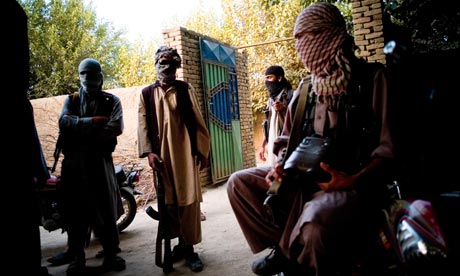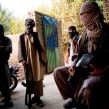
Taliban Expand Insurgency to Northern Afghanistan
Publication: Terrorism Monitor Volume: 7 Issue: 36
By:

Northern Afghanistan, a secure and stable area until last spring, is now an insecure and fearful place. Although Taliban and al-Qaeda activities have been limited mostly to southern Afghanistan over the past eight years, the Taliban were able to expand their terrorist activities to central Afghanistan and since spring 2009, the insurgents have focused their efforts on the most secure place in the country, expanding their terrorist activities to northern Afghanistan.
The expansion of Taliban activities to northern Afghanistan shows that the terrorist networks are getting stronger day to day, causing fear in ordinary Afghans. Taliban attacks on Afghan and international forces are frequently reported from Kunduz and some other northern provinces. Kunduz was the main stronghold of the Taliban in northern Afghanistan during the course of their rule, until 2001. Throughout this period the Taliban organized their raids in other northern provinces from Kunduz. This may be the reason that the insurgents once again want to use this province as a center for organizing terrorist attacks in the northern provinces.
The Taliban Return to Kunduz
The chief of police in Kunduz province, General Abdul Razaq, says the Taliban selected Kunduz as a center for their activities in northern Afghanistan because Kunduz was their stronghold in Afghanistan and they already had some old friends in this province. Though they were dispersed after the U.S. attack on Afghanistan in 2001, the Taliban wants to reorganize them and use their power to make northern Afghanistan insecure. [1]
According to General Abdul Razaq, the Taliban came to northern Afghanistan while NATO and Afghan forces carried out operations against the insurgents in southern Afghanistan. With the Pakistani government conducting an offensive against the terrorists in southern Waziristan at the same time, the Taliban had no place to hide along the Pakistan-Afghanistan border. The Taliban therefore came to northern Afghanistan to expand their activities and switch Afghan and NATO attention from the south to the north.
General Abdul Razaq says Afghan and NATO forces have strengthened their military operations against the insurgents in northern Afghanistan and reduced their terrorist activities. According to the General, an ongoing, three-month-long offensive by NATO and Afghan forces has killed most of the terrorists. Others have been arrested while some have again fled to the southern provinces or Pakistan. “We were able to scatter the insurgents from northern Afghanistan. More than 200 terrorists were killed. A number of them were arrested and some of them fled back to other places. Now the security situation is getting better, only in some of remote areas of some districts we still have some insurgency problems which will be solved soon” said General Abdul Razaq.
Northern Afghanistan has borders with Tajikistan, Uzbekistan and Turkmenistan. According to Afghan security officials and analysts most of the terrorists in northern Afghanistan belong to the Islamic Movement of Uzbekistan (IMU), the network of Taliban leader Jalaludin Haqqani (who has strong connections with al-Qaeda) or Gulbuddin Hekmatyar’s Hezb-e- Islami Afghanistan (Afghanistan Islamic Party), the biggest and most influential mujahideen party during the war against the Soviet Union.. According to General Abdul Razaq, natives of Tajikistan, Uzbekistan and Chechnya are present among Taliban in northern Afghanistan and are always on the frontline of battles with Afghan and NATO forces.
A Lack of Political Will?
Fatima Aziz is a female member of Afghan Parliament from Kunduz province. She blames the government for the insecurity in northern Afghanistan and says that in the beginning, Taliban activities were very limited in northern Afghanistan but the government did not care to keep the Taliban from reaching the northern provinces. “The government could very easily keep the terrorists from reaching the north of the country but they did not. They let the insurgents become very strong and when they made Kunduz and other northern provinces insecure the government and ISAF conducted military operations against them.” [2]
General Abdul Razaq denies charges the government did not take serious steps to counter insurgency in the north, saying that the security forces always used all their facilities to counter insurgency and ensure security for people. According to General Abdul Razaq, terrorism is a regional problem and needs a regional solution, adding, “By the assistance of local people we were able to destroy all those terrorist groups that were active in the north of the country and we exterminated all their plans.”
The Deputy Director of the counterterrorism department at the Ministry of the Interior, Sayed Anwar Ahmadi, agrees with General Abdul Razaq and says that most of the insurgent groups have been destroyed in northern provinces. “Fortunately, due to the last military operations the insurgents are now too weak.” [3]
According to Ahmadi, the Taliban have some forces in northern Kunduz and Baghlan provinces as well as some districts of Faryab province. Ahmadi says that the Taliban is trying to expand their terrorist activities to the north to enable them to attack NATO supply convoys coming through Central Asia and northern Afghanistan.
Cold Weather or Counter-Insurgency Operations?
The security situation is improved in the northern provinces nowadays, but according to Fatima Aziz, the situation improved because the insurgents left the area and went to Pakistan and the southern provinces due to cold weather in the north. She says that the situation will get worse if the insurgents return next spring.
Deputy Director of counterterrorism Sayed Anwar Ahmadi says that before the weather became cold they conducted an offensive against the insurgents and the Taliban fled the area. “The security personnel are always ready to defeat the insurgents. We were never heedless about the insurgency…Cold weather also can be a natural reason for the improving security situation in the north, but [the Taliban] became very weak and had no alternative but to leave the area.”
According to Ahmadi, the insurgents in the north are organizing attacks in small groups against security forces. “There are 15 to 20 groups of insurgents in each province, like Kunduz, Baghlan and some bordering districts of Faryab province. Each group has around twenty people. Besides the networks of Hekmatyar, Tahir Yuldash and Juma Namangani, they have [a] very close connection with the Quetta and Peshawar councils of Taliban in Pakistan.” [4]
Threatening NATO Supply Lines
Political analyst and member of the Afghan Parliament from Kunduz, Moeen Marastyal, sees the NATO decision to ship supplies from Central Asia through Tajikistan to Afghanistan as the main reason for the Taliban presence in northern Afghanistan. [5] Marastyal says that the Taliban want to expand their network first to northern Afghanistan and then to Central Asia where the Uzbek and Tajik Taliban are already active. “By reaching northern Afghanistan they can easily attack NATO supply convoys. Besides reaching their targets in the north they also want to expand their network to Uzbekistan and Tajikistan,” said Marastyal, who claims that local people played a major role in removing terrorists from the northern provinces.
Kunduz province was the first in northern Afghanistan to be captured by Taliban after they seized Kabul in 1996. It remained a Taliban stronghold until October 2001, when U.S. forces attacked Afghanistan and the Taliban regime collapsed. Kunduz was the last province to be cleared of the Taliban and their al-Qaeda allies. Kunduz was a strategic province in northern Afghanistan for the Taliban regime and could again become a place for insurgents to organize their attacks in the north.
Afghan journalist and political analyst Mohammad Qasim Akhgar says that NATO supply convoys from Central Asia through northern Afghanistan are one of the reasons for the Taliban presence in the north. [6] According to Akhgar, there are some countries that want to make Afghanistan insecure and are helping the Taliban to expand their presence to the north of Afghanistan and then to Central Asian nations. Akhgar did not name any of the countries that are helping the insurgents to reach their targets in the north except Pakistan. “Regretfully there are some countries like Pakistan that are helping the Taliban make Afghanistan insecure. Besides foreign countries, there are some people in the Afghan government who also help the Taliban,” said Akhgar.
According to Akhgar the insurgency cannot be solved simply by conducting military operations. “The Afghan insurgency problem needs an economic, political, cultural and military solution. It cannot be solved only by military operations. In Afghanistan the overall situation needs to be changed and become better.”
Notes:
1. Author’s interview with Kunduz chief of police General Abdul Razaq, November 16, 2009
2. Author’s interview with Kunduz MP Fatima Aziz, November 12, 2009
2009
3. Author’s interview with Ministry of the Interior deputy director of counterterrorism Sayed Anwar Ahmadi, November 15, 2009
4. Tahir Yuldash was reported killed by a drone attack in August 2009. Juma Namangani was killed by an airstrike in Afghanistan in late 2001. Both were leaders of the IMU.
5. Author’s interview with Kunduz MP Moeen Marastyal, November 17, 2009
6. Author’s interview with political analyst Mohammad Qasim Akhgar, November 17, 2009





